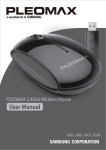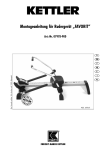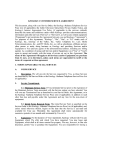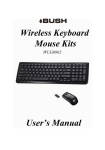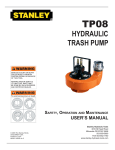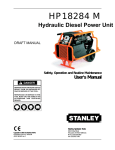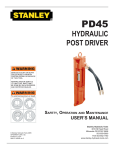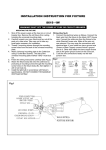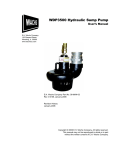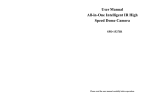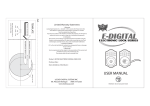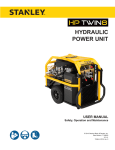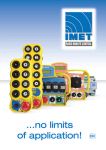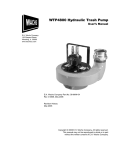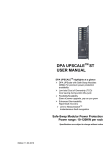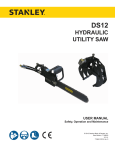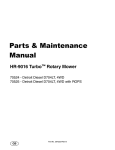Download Mobile Hydraulic Power Unit
Transcript
MHP1 Mobile Hydraulic Power Unit Safety, Operation and Routine Maintenance User's Manual SERIOUS INJURY OR DEATH COULD RESULT FROM THE IMPROPER REPAIR OR SERVICE OF THIS TOOL. REPAIRS AND / OR SERVICE TO THIS TOOL MUST ONLY BE DONE BY AN AUTHORIZED AND CERTIFIED DEALER. Stanley Hydraulic Tools Copyright © 2000 The Stanley Works All Rights Reserved OPS/MAINT USA & CE VERSION Printed in U.S.A. 35599 01/2003 Ver 5 3810 SE Naef Road Milwaukie, OR 97267-5698 USA Phone: (503) 659-5660 Fax: (503) 652-1780 CONTENTS Accessories ........................................................................................... 17 Disengaging Gear Boxes ........................................................................ 16 Hydraulic Hose Requirements .................................................................. 5 Hydraulic Hose & Fitting Connections ................................................. 6 - 7 Loading & Unloading ........................................................................ 13 - 14 Operation .......................................................................................... 8 - 13 Parts Lists ....................................................................................... 18 - 23 Routine Maintenance ....................................................................... 14 - 15 Safety Precautions .............................................................................. 2 - 3 Specifications ......................................................................................... 17 Tool Stickers and Tags ............................................................................. 4 Transporting ........................................................................................... 14 Troubleshooting ...................................................................................... 16 Warranty ................................................................................................ 25 Wiring Diagram ....................................................................................... 24 SERVICING THE MHP1: This manual contains safety, operation, and routine maintenance instructions. Stanley Hydraulic Tools recommends that servicing of this equipment, other than routine maintenance, must be performed by an authorized and certified dealer. Please read the following warning. SERIOUS INJURY OR DEA TH COULD RESUL T FROM DEATH RESULT THE IMPROPER REP AIR OR SERVICE OF THIS TOOL REPAIR TOOL.. REP AIRS AND / OR SERVICE TO THIS TOOL MUST REPAIRS ONL Y BE DONE B Y AN A UTHORIZED AND CERTIFIED ONLY BY AUTHORIZED DEALER. 1 SAFETY Tool operators and maintenance personnel must always comply with the safety precautions given in this manual and on the stickers and tags attached to the machine. These safety precautions are given for your safety. Review them carefully before operating the machine and before performing general maintenance or routine service. Supervising personnel should develop additional precautions relating to the specific work area and local safety regulations. If so, place the added precautions in the space provided on page 3. GENERAL SAFETY PRECAUTIONS If you have not read this manual or the engine manual, you are not ready to operate the MHP1. Read and understand this manual and any stickers and tags attached to the machine before operation. Failure to do so can result in equipment damage, personal injury, or death. • Operate the machine in a work area without bystanders. The operator must be familiar with all prohibited work areas such as excessive slopes and dangerous terrain conditions. • DO NOT operate the machine ACROSS excessive slopes where "tip over" is a hazard. • DO NOT operate the machine in confined areas where there may be a risk of crushing the operator between the machine and another object. • DO NOT operate the machine in enclosed spaces. Inhalation of engine exhaust can be fatal. • DO NOT wear loose clothing that can get entangled in the working parts of the machine or hydraulic tools. • DO NOT add fuel to the machine while it is running or still hot. • DO NOT operate the machine if a fuel odor is present. • DO NOT operate the machine within 3.3 ft./1 m of buildings, obstructions, or flammable objects. • Allow the engine to cool before storing the machine in an enclosure. • DO NOT ride on, or allow anyone else to ride on, the machine at any time. • Establish a training program for all operators to ensure safe operation. • DO NOT operate the machine unless thoroughly trained or under the supervision of an instructor. • Always wear safety equipment such as goggles, ear, head protection, and safety shoes at all times when operating the machine. • DO NOT inspect or clean the machine while the engine is running. Accidental engagement of the machine can cause serious injury or death. • The hydraulic circuit control valve must be in the "OFF"position when coupling or uncoupling hydraulic tools. 2 SAFETY Continued . . . Wipe all couplers clean before connecting. Use only lint-free cloths. Failure to do so may result in damage to the quick couplers and cause overheating of the hydraulic system. • Before operating hydraulic tools, read and understand the operation manual furnished with the tool. • DO NOT operate a damaged, or improperly adjusted, machine. • DO NOT weld or cut with an acetylene torch any surface or component of the equipment. Consult with the Stanley factory before performing any welding or acetylene cutting of the equipment. • Prevent possible personal injury or equipment damage by having all repair, maintenance and service performed only by authorized and properly trained personnel. • DO NOT exceed the rated limits of the equipment or use the equipment for applications beyond its design capacity. • Always keep critical markings, such as lables and warning stickers legible. • Always replace parts with replacement parts recommended by Stanley Hydraulic Tools. SAFETY SYMBOLS Safety symbols are used to emphasize all operator, maintenance and repair actions which, if not strictly followed, could result in a life-threatening situation, bodily injury or damage to equipment. This safety symbol may appear on the machine. It is used to alert the operator of an action that could place him/her or others in a life threatening situation. This safety symbol appears in these instructions to identify an action that could cause bodily injury to the operator or other personnel. This safety symbol appears in these instructions to identify an action or condition that could result in damage to the tool or other equipment. Always observe safety symbols. They are included for your safety and for the protection of the tool. LOCAL SAFETY REGULATIONS Enter any local safety regulations here. Keep these instructions in an area accessible to the operator and maintenance personnel. 3 TOOL STICKERS & TAGS Stanley Decal P/N-05154 Dual Circuit Valve Block Decal P/N-28045 TracHorse Decal P/N-59046 Lift Location Decal P/N-59045 TracHorse Decal P/N-59046 Hydraulic Fluid Decal P/N-35686 Lift Location Decal P/N-59045 Limit Engine Speed Decal P/N-59044 Caution Decal P/N-28089 Gas Throttle Decal P/N-59043 TracHorse Decal P/N-59046 Dual Circuit Valve block Decal P/N-28045 Start-Up Decal P/N-59041 (Dual Circuit) P/N-59042 (Single Circuit) Choke Decal P/N-07764 Caution Decal P/N-28089 Choke Decal P/N-07764 Start-Up Decal P/N 59042 (Single Circuit) Start-Up Decal P/N 59041 (Dual Circuit) Hydraulic Fluid Decal P/N-35686 D A N G E R Lift Location Decal P/N-59045 D A N G E R 1. FAILURE TO USE HYDRAULIC HOSE LABELED AND CERTIFIED AS NON-CONDUCTIVE WHEN USING HYDRAULIC TOOLS ON OR NEAR ELECTRICAL LINES MAY RESULT IN DEATH OR SERIOUS INJURY. BEFORE USING HOSE LABELED AND CERTIFIED AS NON-CONDUCTIVE ON OR NEAR ELECTRIC LINES BE SURE THE HOSE IS MAINTAINED AS NON-CONDUCTIVE. THE HOSE SHOULD BE REGULARLY TESTED FOR ELECTRIC CURRENT LEAKAGE IN ACCORDANCE WITH YOUR SAFETY DEPARTMENT INSTRUCTIONS. 2. A HYDRAULIC LEAK OR BURST MAY CAUSE OIL INJECTION INTO THE BODY OR CAUSE OTHER SEVERE PERSONAL INJURY. A DO NOT EXCEED SPECIFIED FLOW AND PRESSURE FOR THIS TOOL. EXCESS FLOW OR PRESSURE MAY CAUSE A LEAK OR BURST. B DO NOT EXCEED RATED WORKING PRESSURE OF HYDRAU LIC HOSE USED WITH THIS TOOL. EXCESS PRESSURE MAY CAUSE A LEAK OR BURST. C CHECK TOOL HOSE COUPLERS AND CONNECTORS DAILY FOR LEAKS. DO NOT FEEL FOR LEAKS WITH YOUR HANDS. CONTACT WITH A LEAK MAY RESULT IN SEVERE PERSONAL INJURY. The safety tag (p/n 15875) at right is attached to the machine when shipped from the factory. Read and understand the safety instructions listed on this tag before removal. We suggest you retain this tag and attach it to the machine when not in use. D DO NOT LIFT OR CARRY TOOL BY THE HOSES. DO NOT ABUSE HOSE. DO NOT USE KINKED, TORN OR DAMAGED HOSE. 3. MAKE SURE HYDRAULIC HOSES ARE PROPERLY CONNECTED TO THE TOOL BEFORE PRESSURING SYSTEM. SYSTEM PRESSURE HOSE MUST ALWAYS BE CONNECTED TO TOOL "IN" PORT. SYSTEM RETURN HOSE MUST ALWAYS BE CONNECTED TO TOOL "OUT" PORT. REVERSING CONNECTIONS MAY CAUSE REVERSE TOOL OPERATION WHICH CAN RESULT IN SEVERE PERSONAL INJURY. 4. DO NOT CONNECT OPEN-CENTER TOOLS TO CLOSED-CENTER HYDRAULIC SYSTEMS. THIS MAY RESULT IN LOSS OF OTHER HYDRAULIC FUNCTIONS POWERED BY THE SAME SYSTEM AND/ OR SEVERE PERSONAL INJURY. 5. BYSTANDERS MAY BE INJURED IN YOUR WORK AREA. KEEP BYSTANDERS CLEAR OF YOUR WORK AREA. 6. WEAR HEARING, EYE, FOOT, HAND AND HEAD PROTECTION. 7. TO AVOID PERSONAL INJURY OR EQUIPMENT DAMAGE, ALL TOOL REPAIR MAINTENANCE AND SERVICE MUST ONLY BE PERFORMED BY AUTHORIZED AND PROPERLY TRAINED PERSONNEL. I M P O R TA N T I M P O R TA N T READ OPERATION MANUAL AND SAFETY INSTRUCTIONS FOR THIS TOOL BEFORE USING IT. READ OPERATION MANUAL AND SAFETY INSTRUCTIONS FOR THIS TOOL BEFORE USING IT. USE ONLY PARTS AND REPAIR PROCEDURES APPROVED BY STANLEY AND DESCRIBED IN THE OPERATION MANUAL. USE ONLY PARTS AND REPAIR PROCEDURES APPROVED BY STANLEY AND DESCRIBED IN THE OPERATION MANUAL. TAG TO BE REMOVED ONLY BY TOOL OPERATOR. TAG TO BE REMOVED ONLY BY TOOL OPERATOR. SEE OTHER SIDE 15875 SEE OTHER SIDE 15875 SAFETY TAG P/N 15875 (shown smaller then actual size) 4 TOOL CIRCUIT HYDRAULIC HOSE REQUIREMENTS HOSE TYPES Hydraulic hose types authorized for use with Stanley Hydraulic Tools are as follows: ➊ Certified non-conductive ➋ Wire-braided (conductive) ➌ Fabric-braided (not certified or labeled non-conductive) Hose ➊ listed above is the only hose authorized for use near electrical conductors. Hoses ➋ and ➌ listed above are conductive and must never be used near electrical conductors. HOSE SAFETY TAGS To help ensure your safety, the following DANGER tags are attached to all hose purchased from Stanley Hydraulic Tools. DO NOT REMOVE THESE TAGS. If the information on a tag is illegible because of wear or damage, replace the tag immediately. A new tag may be obtained at no charge from your Stanley Distributor. D A N G E R D A N G E R 1 FAILURE TO USE HYDRAULIC HOSE LABELED AND CERTIFIED AS NON-CONDUCTIVE WHEN USING HYDRAULIC TOOLS ON OR NEAR ELECTRIC LINES MAYRESULT IN DEATH OR SERIOUS INJURY. FOR PROPER AND SAFE OPERATION MAKE SURE THAT YOU HAVE BEEN PROPERLY TRAINED IN CORRECT PROCEDURES REQUIRED FOR WORK ON OR AROUND ELECTRIC LINES. 3. DO NOT EXCEED HOSE WORKING PRESSURE OR ABUSE HOSE. IMPROPER USE OR HANDLING OF HOSE COULD RESULT IN BURST OR OTHER HOSE FAILURE. KEEP HOSE AS FAR AWAY AS POSSIBLE FROM BODY AND DO NOT PERMIT DIRECT CONTACT DURING USE. CONTACT AT THE BURST CAN CAUSE BODILY INJECTION AND SEVERE PERSONAL INJURY. 2. BEFORE USING HYDRAULIC HOSE LABELED AND CERTIFIED AS NON-CONDUCTIVE ON OR NEAR ELECTRIC LINES. WIPE THE ENTIRE LENGTH OF THE HOSE AND FITTING WITH A CLEAN DRY ABSORBENT CLOTH TO REMOVE DIRT AND MOSISTURE AND TEST HOSE FOR MAXIMUM ALLOWABLE CURRENT LEAKAGE IN ACCORDANCE WITH SAFETY DEPARTMENT INSTRUCTIONS. 4. HANDLE AND ROUTE HOSE CAREFULLY TO AVOID KINKING, ABRASION, CUTTING, OR CONTACT WITH HIGH TEMPERATURE SURFACES. DO NOT USE IF KINKED. DO NOT USE HOSE TO PULL OR LIFT TOOLS, POWER UNITS, ETC. 5. CHECK ENTIRE HOSE FOR CUTS CRACKS LEAKS ABRASIONS, BULGES, OR DAMAGE TO COUPLINGS IF ANY OF THESE CONDITIONS EXIST, REPLACE THE HOSE IMMEDIATELY. NEVER USE TAPE OR ANY DEVICE TO ATTEMPT TO MEND THE HOSE. DO NOT REMOVE THIS TA G DO NOT REMOVE THIS TA G The tag shown below is attached to "certified non-conductive" hose. 6. AFTER EACH USE STORE IN A CLEAN DRY AREA. SEE OTHER SIDE 3 SIDE 1 SEE OTHER SIDE (shown smaller than actual size) SIDE 2 The tag shown below is attached to "conductive" hose. DO NOT REMOVE THIS TA G 1 DO NOT USE THIS HYDRAULIC HOSE ON OR NEAR ELECTRIC LINES. THIS HOSE IS NOT LABELED OR CERTIFIED AS NON-CONDUCTIVE. USING THIS HOSE ON OR NEAR ELECTRICAL LINES MAY RESULT IN DEATH OR SERIOUS INJURY. 2. FOR PROPER AND SAFE OPERATION MAKE SURE THAT YOU HAVE BEEN PROPERLY TRAINED IN CORRECT PROCEDURES REQUIRED FOR WORK ON OR AROUND ELECTRIC LINES. 5. CHECK ENTIRE HOSE FOR CUTS CRACKS LEAKS ABRASIONS, BULGES, OR DAMAGE TO COUPLINGS IF ANY OF THESE CONDITIONS EXIST, REPLACE THE HOSE IMMEDIATELY. NEVER USE TAPE OR ANY DEVICE TO ATTEMPT TO MEND THE HOSE. 6. AFTER EACH USE STORE IN A CLEAN DRY AREA. 3. DO NOT EXCEED HOSE WORKING PRESSURE OR ABUSE HOSE. IMPROPER USE OR HANDLING OF HOSE COULD RESULT IN BURST OR OTHER HOSE FAILURE. KEEP HOSE AS FAR AWAY AS POSSIBLE FROM BODY AND DO NOT PERMIT DIRECT CONTACT DURING USE. CONTACT AT THE BURST CAN CAUSE BODILY INJECTION AND SEVERE PERSONAL INJURY. 4. HANDLE AND ROUTE HOSE CAREFULLY TO AVOID KINKING, CUTTING, OR CONTACT WITH HIGH TEMPERATURE SURFACES. DO NOT USE IF KINKED. DO NOT USE HOSE TO PULL OR LIFT TOOLS, POWER UNITS, ETC. DO NOT REMOVE THIS TA G D A N G E R D A N G E R SEE OTHER SIDE SEE OTHER SIDE SIDE 1 (shown smaller than actual size) SIDE 2 HOSE PRESSURE RATING The rated working pressure of the hydraulic hose must be equal to or higher than the relief valve setting on the hydraulic system. 5 HOSE & FITTING CONNECTIONS for SINGLE CIRCUIT ADAPTER, 1/2 INCH MALE PIPE x -10 SAE O-RING (STANLEY P/N 07882 ADAPTER) H.T.M.A. 1/2 INCH FEMALE QUICK DISCONNECT COUPLER (STANLEY P/N 24060 COUPLER BODY or STANLEY P/N 03974 COUPLER SET - nose & body) H.T.M.A. 1/2 INCH MALE QUICK DISCONNECT COUPLER (STANLEY P/N 24061 COUPLER NOSE or STANLEY P/N 03974 COUPLER SET - nose & body) 31972 Assy w/couplers. 31848 Hose Assy w/couplers 1/2 INCH I.D. HOSE, 25 FT TO 50 FT LONG. (FOR 25 FEET, STANLEY P/N 04972 HYDRAULIC HOSE or STANLEY P/N 05009 DUAL HYDRAULIC HOSES) (FOR 50 FEET, STANLEY P/N 04978 HYDRAULIC HOSE or STANLEY P/N 05008 DUAL HYDRAULIC HOSES) 1/2 INCH MALE PIPE HOSE END H.T.M.A. 1/2 INCH FEMALE QUICK DISCONNECT COUPLER (STANLEY P/N 24060 COUPLER BODY or STANLEY P/N 03974 COUPLER SET - nose & body) H.T.M.A. 1/2 INCH MALE QUICK DISCONNECT COUPLER (STANLEY P/N 24061 COUPLER NOSE or STANLEY P/N 03974 COUPLER SET - nose & body) ADAPTER, 3/8 INCH MALE PIPE x -8 SAE O-RING (STANLEY P/N 00936 ADAPTER) NOTE: ADAPTERS OR HOSE WHIPS ARE INCLUDED WITH TOOLS. 6 HOSE & FITTING CONNECTIONS for DUAL CIRCUIT TOOL COUPLERS CONTROL LEVER VALVE BLOCK H.T.M.A. 1/2 INCH MALE QUICK DISCONNECT COUPLER (STANLEY P/N 24061 COUPLER NOSE or STANLEY P/N 03974 or 24070COUPLER SET - nose & body) H.T.M.A. 1/2 INCH FEMALE QUICK DISCONNECT COUPLER (STANLEY P/N 24060 COUPLER BODY or STANLEY P/N 03974 or 24070 COUPLER SET - nose & body) 1/2 INCH I.D. HOSE, 25 FT TO 50 FT LONG. (FOR 25 FEET, STANLEY P/N 04978 HYDRAULIC HOSE or STANLEY P/N 05008 DUAL HYDRAULIC HOSES) (FOR 50 FEET, STANLEY P/N 04979 HYDRAULIC HOSE or STANLEY P/N 05009 DUAL HYDRAULIC HOSES) 1/2 INCH MALE PIPE HOSE END H.T.M.A. 1/2 INCH MALE QUICK DISCONNECT COUPLER (STANLEY P/N 24061 COUPLER NOSE or STANLEY P/N 03974 or 24070 COUPLER SET - nose & body) H.T.M.A. 1/2 INCH FEMALE QUICK DISCONNECT COUPLER (STANLEY P/N 24060 COUPLER BODY or STANLEY P/N 03974 COUPLER SET - nose & body) ADAPTER, 3/8 INCH MALE PIPE x -8 SAE O-RING (STANLEY P/N 00936 ADAPTER) NOTE: ADAPTERS OR HOSE WHIPS ARE INCLUDED WITH TOOLS. 7 OPERATING INSTRUCTIONS PREOPERATION PROCEDURES Engine Fuel Level Check the fuel level. If low, fill with unleaded gasoline with a minimum of 85 octane rating. Preparation For Initial Use Warning Lights The equipment, as shipped, has no special unpacking or assembly requirements prior to usage. Inspection to assure the equipment was not damaged in shipping, does not contain packing debris, and checking fluid levels as described below, is all that is required. Engine Oil Level Before each use, check the engine oil level. Make sure the engine oil level is at the FULL MARK on the dipstick. Do not overfill. Use detergent oil classified "For Service SE, SF, SG" as specified in the engine operating and maintenance manual. Engine Oil A warning light is located on the instrument panel near the ignition key. The light comes on when the ignition key is turned to the "ON" position. After the engine is started, the light should turn off. If the light stays on, the engine oil is low. Shut down the engine immediately and check the engine oil level. Add oil as required. The engine oil dipstick is located on the right side of the engine for both the Honda and B & S engines. Engine Oil Filler Cap Low Engine Oil Warning Light Hydraulic Fluid A warning light is located on the instrument panel near the ignition key. The light DOES NOT COME ON when the ignition key is turned to the "ON" position unless the hydraulic fluid level is too low. If the hydraulic fluid level is too low, the light will stay on after the engine has been started. Shut down the engine immediately and add hydraulic fluid as required. When the hydraulic fluid level is correct, the light should not be on. Engine Oil Dipstick HONDA ENGINE Engine Oil Filler Cap Engine Oil Dipstick BRIGGS & STRATTON ENGINE LowHydraulic Fluid Warning Light Low hydraulic fluid indicates a leak in the hydraulic system. Inspect all hydraulic connections and hydraulic components for leaks. DO NOT use the equipment until leaks are repaired. 8 damage the starter motor. OPERATION Location of Instruments, Switches, and Controls 1 5. After the engine starts, allow it to warm-up for a few seconds before moving the choke. Move the choke inward in small steps to allow the engine to accept small changes in speed and load. Continue moving the choke in until it is fully off and the engine is running smoothly. 6. Adjust the throttle for the work to be done. See "Adjusting Throttle For Various Types of Work". 2 Stopping The Engine 7 1. Move the throttle to the "SLOW" position. 3 8 4 6 5 9 2. Ensure the tool circuit control lever(s) are in the OFF position and the tool circuit switch is in the "OFF" position. 3. Turn the ignition key counter clockwise to the "OFF" position. Adjusting Throttle for Various Types of Work 10 NOTE: Use caution when operating or ordering items 3 & 7 they can come installed oppisite of what is illustrated above. The Bed up/down switch is spring loaded and will return to the center position when released. The tool ciucuit on/off switch is either on or off (2 way) no center position. 1. 2. 3. 4. 5. 6. 7. 8. 9. 10. Left & Right Track Controls for Forward, Reverse, and Left, Right Steering Throttle Tool Circuit ON/OFF Switch Hour Meter Key Ignition Warning Lights Bed UP/DOWN Switch Choke Tool Circuit Controls Fuel Shutoff Starting The Engine 1. Ensure the tool circuit control lever(s) are in the OFF position and the tool circuit switch is in the OFF position. 2. Pull the choke out until it stops. 3. Move the throttle to a position between "SLOW" and "FAST". 4. Turn the ignition key clockwise to begin cranking the engine. Use short starting cycles (15 seconds per minute) to prolong starter life. Extended cranking can 9 Forward Travel The throttle can be positioned anywhere between "SLOW" and "FAST" for traveling forward depending on the weight of the load being carried. Heavy loads will require higher throttle settings in order for the engine to provide enough power to move the load. Reverse Travel Position the throttle to "SLOW" for reverse travel to permit increased control and safety. DO NOT attempt to travel in reverse with the throttle positioned above "SLOW". This may result in loss of control and result in injury or death to the operator. Bed Cylinder The throttle may be positioned anywhere between "SLOW" and "FAST" when operating the bed. Tool Circuit The throttle must be positioned to "FAST" when using the tool circuit. Slower throttle settings will stall the engine or provide reduced oil flow. Slope Operation DO NOT operate the machine on slopes exceeding 60 degrees in the travel direction or across slopes exceeding 45 degrees.. Avoid turning on slopes. If you must turn, turn slowly downhill, if possible. DO NOT operate the machine near drop-offs, ditches, or embankments. The machine could suddenly turn over if a track goes over the edge or if an edge collapses. DO NOT try to stabilize the machine if it is tipping over. Let go of the machine and get out of its way. Traveling Forward or Reverse TO TRAVEL FORWARD Move Both Controls Forward TO TURN LEFT WHILE MOVING FORWARD: Release the left track control while pushing forward on the right track control. Resume pushing forward on the left track control to move forward in a straight line. When first learning to operate the Track Horse, position the throttle to the "SLOW" position. More experienced operators may use higher throttle settings. TO TURN LEFT WHILE MOVING FORWARD Release left control while holding right control forward TO TURN RIGHT WHILE MOVING FORWARD: Release the right track control while pushing forward on the left track control. Resume pushing forward on the right track control to move forward in a straight line. Track Steering Controls To travel forward, reverse, turn left, or turn right, do the following: Forward Travel TO MOVE FORWARD IN A STRAIGHT LINE: Move both the left and right track controls forward at the same time. TO TURN RIGHT WHILE MOVING FORWARD Release right control while holding left control forward 10 Reverse Travel DO NOT attempt to travel in reverse with the throttle positioned above "SLOW". This may result in loss of control and result in injury or death to the operator. TO TURN RIGHT WHILE MOVING BACKWARD: Release the right track control while pulling backward on the left track control. Resume pulling backward on the right track control to move backward in a straight line. TO MOVE BACKWARDS IN A STRAIGHT LINE: Move both the left and right track controls backward at the same time. TO TURN RIGHT WHILE MOVING BACKWARD Release right control while holding left control backward Turning From A Stop TO TRAVEL BACKWARD Move Both Controls Backward TO TURN LEFT WHILE MOVING BACKWARD: Release the left track control while pulling backward on the right track control. Resume pulling backward on the left track control to move backward in a straight line. TO TURN LEFT FROM A STOP: Move the right track control forward and the left track control backward. TO TURN LEFT FROM A STOP Move the right control forward and the left control backward TO TURN RIGHT FROM A STOP: Move the left track control forward and the right track control backward. TO TURN LEFT WHILE MOVING BACKWARD Release left control while holding right control backward TO TURN RIGHT FROM A STOP Move the leftcontrol forward and the right control backward 11 Bed Operation Using The Tool Circuit 1. Adjust the throttle to a "SLOW" to "MEDIUM" setting. 2. Press the rocker switch on the instrument panel to raise or lower the bed. 1. Ensure the tool circuit ON/OFF switch located on the instrument panel is in the "OFF" position and the throttle is in the "SLOW" position. 2. Connect hydraulic hoses from the tool to the pressure and return couplers of the tool circuit. The recommended hose length to use with hydraulic tools is 25 ft/8 mm with a 1/2 inch/12.7 mm inside diameter. See the pages covering hydraulic hose requirements and connections found earlier in this manual. 3. Adjust the throttle to the "FAST" position. 4. Press the tool circuit ON/OFF switch to the "ON" position. Ensure the tailgate has been removed before lifting the dump bed. This will prevent loaded material from staying in the dump bed which may cause the equipment to become unstable. Hydraulic Tool Operation Single Tool Circuit (model MHP11111000) The single tool circuit found on the TracHorse model MHP11111000 produces 8 gpm/30 lpm with pressure up to 2000 psi/140 bar. 5. Activate the tool circuit by moving the ON/OFF control lever to the right. 6. When finished using the tool, move the control lever to the left, press the tool circuit ON/OFF switch to the "OFF" position, and move the throttle to the "SLOW" position. 1 Before disconnecting hydraulic tools, ensure the tool circuit control lever is in the "OFF" position and the throttle is in the "SLOW" position. Dual Tool Circuit (model MHP12211000) 3 2 Single Tool Circuit on model MHP11111000 Above illustration shown in the OFF position 1. 2. 3. ON/OFF Control Male Coupler (Pressure) Female Coupler (Return) The dual tool circuit found on the TracHorse model MHP12211000 provides two hydraulic tool circuits, each with an oil flow of 5 gpm/19 lpm with pressure up to 2000 psi/140 bar. The two circuits may be combined into one circuit providing 10 gpm/38 lpm and pressure up to 2000 psi/140 bar. 12 5. Press the tool circuit ON/OFF switch to the "ON" position. 5 2 7 6. Activate each tool circuit by moving the control lever up. If only one tool is connected, activate that circuit only. 1 4 3 6 Dual Tool Circuit on model MHP12211000 Above illustration shown in the OFF position 1. ON/OFF Control, Left Tool Circuit 2. Male Coupler (Pressure), Left Tool Circuit 3. Female Coupler (Return), Left Tool Circuit 4. ON/OFF Control, Right Tool Circuit 5. Male Coupler (Pressure), Right Tool Circuit 6. Female Coupler (Return), Right Tool Circuit 7. Circuit Combiner Knob 7. When finished using the tool or tools, move the control lever(s) down, press the tool circuit ON/OFF switch to the "OFF" position, and move the throttle to the "SLOW" position. Before disconnecting hydraulic tools, ensure the tool circuit control levers are in the down position and the throttle is in the "SLOW" position. Using 1 or 2 Tool Circuits at 5 gpm/19 lpm 1. Ensure the tool circuit ON/OFF switch located on the instrument panel is in the "OFF" position and the throttle is in the "SLOW" position. 2. Push the circuit combiner knob "IN". When the circuit combiner knob is pushed in, either the left, right, or both circuits may be used. When the circuit combiner knob is pulled out, the two circuits are combined into one 10 gpm/38 lpm circuit but only one circuit may be used. 3. If using only one tool, connect hydraulic hoses from the tool to the pressure and return couplers of either the left or right circuit. If using two tools connect hydraulic hoses from each tool to the pressure and return couplers of each circuit. The recommended hose length to use with hydraulic tools is 25 ft/8 mm with a 1/2 inch/12.7 mm inside diameter. See the pages covering hydraulic hose requirements and connections found earlier in this manual. 4. Adjust the throttle to the "FAST" position. 13 Using 1 Tool Circuit at 10 gpm/38 lpm 1. Ensure the tool circuit ON/OFF switch located on the instrument panel is in the "OFF" position and the throttle is in the "SLOW" position. 2. Pull the circuit combiner knob "OUT". 3. Connect hydraulic hoses from the tool to the pressure and return couplers of either the left or right circuit. The other circuit must not have a tool connected to it or have the hoses connected from the pressure and return couplers. DO NOT cross from one circuit to the other. 4. Adjust the throttle to the "FAST" position. 5. Press the tool circuit ON/OFF switch to the "ON" position. 6. Activate the tool circuit by moving both control levers up. 7. When finished using the tool, move the control levers down, press the tool circuit ON/OFF switch to the "OFF" position, and move the throttle to the "SLOW" position. TRANSPORTING Before disconnecting hydraulic tools, ensure the tool circuit control levers are in the down position and the throttle is in the "SLOW" position. COLD WEATHER OPERATION Fluids are thicker in cold weather, therefore, it is recommended that the engine be run at low idle long enough to warm the engine and bring the hydraulic system temperature to a minimum of 50°F/10°C. If hydraulic tools and hoses are to be used, it is recommended to allow hydraulic fluid to circulate through the tools and hoses until warm before use. LOADING AND UNLOADING 1. Use loading ramps or a loading dock to load and unload the machine. Ensure loading ramps are strong enough to support the load. When using ramps, do not exceed a 15 degree incline. 1. Read the instructions for loading and unloading in this section. 2. Use chains and binders to secure the load to the trailer. ROUTINE MAINTENANCE Good maintenance practices will keep the machine on the job and increase its service life. A very important maintenance practice is to keep the hydraulic fluid clean at all times. Contaminated hydraulic fluid causes rapid wear and/or failure of internal parts. Follow the maintenance instructions contained in the engine manual. Engine Maintenance Follow the maintenance schedule and general maintenance instructions in the engine maintenance and operation manual furnished with the power unit. Normal maintenance includes: • Service foam air pre-cleaner every 25 hours of operation. • Service air paper cartridge every 100 hours of operation. • Replace in-line fuel filter every 100-300 hours or sooner if required. • Replace spark plugs every 100 hours of operation. • 4. Drive the machine onto the trailer backwards (engine first). This will help prevent instability and keeps the operator "up hill" from the machine during loading and unloading. Change engine oil after first 5 hours of operation, then after every 50 hours of operation. If engine has been operating under heavy load or in high ambient temperature, change the oil every 25 hours of operation. • Change oil filter when engine oil is changed. • Check oil level daily. 5. After loading, place chocks at the front and rear of the tracks. • Remove dirt and debris from engine with a cloth or brush daily. Do not use water spray. • Clean air cooling system every 100 hours of operation. 14 Loading and unloading of any type of machine is dangerous. Never attempt to load or unload the machine without loading ramps or a loading dock. Loading ramps must be strong enough, have a low angle, and correct height. Load and unload the machine on a level surface. Never attempt to load or unload the machine if the ramp incline exceeds 15 degrees. Failure to follow these instructions may result in serious injury or death. 2. Ensure the wheels of the trailer and the tow vehicle have been chocked front and rear. 3. Use the "SLOW" throttle setting when loading or unloading. Hydraulic System Maintenance c. Checking Suction Hose Observe the following for maximum performance and service life from the hydraulic system. • Always keep hydraulic system and fluids clean. • Keep water out of fluid. (See paragraph b. below.) • Keep air out of hydraulic lines. Hydraulic system overheating and foam at the hydraulic tank breather indicate air is present in the lines. Keep all suction line fittings and clamps tight. Make sure the suction hose (from the hydraulic tank to the pump inlet) is not kinked and is clamped securely. This reduces the risk of pump cavitation and sucking air into the system. All pump fittings should be tight. d. Checking Hydraulic Lines and Fittings Check for loose fittings, leaks, etc., throughout the hydraulic circuit. Hydraulic Fluid Recommendations • • Hydraulic system wear is noted by increased heat during tool operation, reduced tool performance and eventual system breakdown. Viscosity (Fluid Thickness) U.S. METRIC Operate with the fluid temperature at 50 - 140 F/10 60 C for improved seal and hose life, and maximum efficiency. 50°F 450 SSU Maximum 100°F 130-200 SSU 140°F 85 SSU Minimum 10°C 95 CST Maximum 38°C 27-42 CST 60°C 16.5 CST Minimum a. Filling The Reservoir Make sure the engine is stopped before opening the fillerr cap. Fill slowly with the recommended fluid. Add fluid as needed. Secure the filler cap before restarting the engine. Refer to page # 8 (hydraulic fluid) section for determining correct fluid level. b. Removing Condensed Moisture From Hydraulic Fluid Condensation is a frequent problem with cool mobile hydraulic circuits. This condition occurs in moist or cold climates. When warm air in the hydraulic tank draws moisture from the cooler air outside, water accumulates in the tank. • Allow the fluid to sit long enough for the water to settle to the bottom of the container. Slowly pour the fluid back into the hydraulic tank, avoiding the water at the bottom of the container. • Check hydraulic lines and fittings for leaks, kinks,etc. daily. Do not use your hand to perform this check. • Change the hydraulic filter element every 200 hours of operation. Change more often if cold, moist or dusty conditions exist. • Check oil cooler for debris. Remove debris with air pressure. 15 PourPoint -10°F/-23°C Minimum (for cold startup) Vicsosity Index (ASTM D-2220) 140 Minimum Demulsibility (ASTM D-1401) 30 Minutes Maximum Flash Point (ASTM D-92) 340°F/171°C Minimum Rust Inhibition (ASTM D-665 A & B) Pass Oxidation (ASTM D-943) 1000 Hours Minimum Pump Wear Test (ASTM D-2882) 60 mg Maximum The following fluids work well over a wide temperature range at starup, allow moisture to settle out and resist biological growth that may occur in cool operating hydraulic circuits. These fluids are recommended by Stanley Hydraulic Tools. Other fluids that meet or exceed the specifications of these fluids may also be used. Chevron AW-MV-32 Exxon "Univis" J-26 Mobil D.T.E. 13 Gulf "Harmony" AW-HVI-150-32 Shell "Tellus" T-32 Texaco "Rando" HD-AZ Union "Unax" AW-WR-32 TROUBLE SHOOTING If symptoms of poor performance develop, the following chart can be used as a guide to correct the problem. listed in the table. Use a flowmeter known to be accurate. Check the flow with the hydraulic oil temperature at least 80°F/27°C. When diagnosing faults in operation of the machine or tool, always check that the hydraulic power source is supplying the correct hydraulic flow and pressure as Machine will not start Fuel filter plugged Replace fuel filter Defective spark plugs. Remove plugs, check gap, clean or replace Tool circuit switch is on Push tool circuit switch off Tool circuit lever(s) are "ON" Move tool circuit levers to "OFF" Tool circuit switch is "ON" Push tool circuit switch "OFF" Not enough throttle Increase throttle setting Machine stalls when track controls are pushed Heavy load Increase throttle setting Hydraulic tool will not operate Tool circuit switch is "OFF" Push tool circuit switch "ON" Tool circuit lever(s) are down Move tool circuit lever(s) up Not enough throttle Move throttle to FAST position Incorrect tool/hose connection Check for correct connections Quick disconnect fittings defective Detach tool from hose, connect hoses together, check for free flow Relief valve defective Have unit serviced by authorized technician Hydraulic fluid low Add recommended fluid Defective gear box(es) Disengage gear boxes to move machine One or more defective hydraulic component Disengage gear boxes to move machine Machine will not move when track controls are pushed Machine cannot be moved using hydraulic controls TO ENGAGE OR DISENGAGE GEAR BOXES Note: On the exterior of each gearbox is a round knob. Behind the knob is a detent pin. Each track gear box can be disengaged by pulling the detent pin out, and at the same time, pulling the round knob out. To engage the gearbox, pull the detent pin, and at the same time, push the round knob in. It may be necessary to rock the machine back and forth to disengage or engage each gear box. When the gearboxes are disengaged, the machine may be moved by pushing or pulling (hydraulics and controls are no longer valid). 16 SPECIFICATIONS Engine (model MHP11111000) ................................................................................................ 18 hp Briggs & Stratton (model MHP12211000) ............................................................................................................. 20 h.p. Honda Fuel Capacity .................................................................................................................................................. 9 qt/8.5 ltr Fuel Type ................................................................................................. Unleaded Gasoline w/ 85 Octane Minimum Pressure Range ................................................................................................................................. 2000 psi/140 bar Flow Range (model MHP11111000) ....................................................................................................... 8 gpm/30 lpm (model MHP12211000) ................................................................................................... 10 gpm/38 lpm Couplers ............................................................................................. HTMA/EHTMA Flush Face Type Male & Female Connect Size and Type .......................................................................................................... 3/8 in. Male Pipe Adapter Weight ..................................................................................................................................................... 1300 lb/590 kg Maximum Pay Load ................................................................................................................................ 1000 lb/454 kg Overall Length ........................................................................................................................................ 82 in. / 208 cm Overall Width ............................................................................................................................................ 32 in. / 81 cm Overall Heigth ......................................................................................................................................... 43 in. / 109 cm Oil Capacity...........................................................................................................................................................................4.5 Gallon FILTERS TRACK HORSE MODEL ENGINE OIL FILTER AIR FILTER HYDRAULIC COMMENTS FUEL FILTER OIL FILTER MHP11111000 MHP12211000 18384 40458 47435 47435 18382 40459 40463 40463 B&S HONDA KEYS KE Seal Kit for Lift Cylinder Ignition Key Ignition Key 39220 39221 CIAM Key (CAMISA) 02193 Indak Key Set (Briggs switch) ACCESSORIES 17 DESCRIPTION PART NUMBER Coupler Nose, 3/8 Port, Bruning Coupler Body, 3/8 Port, Bruning Coupler Set, 3/8 Port , Bruning (includes nose & body) 03972 03973 03971 Coupler Nose, 3/8 Port Coupler Body, 3/8 Port Coupler Set, 3/8 Port, (includes nose & body) 24059 24058 24069 Coupler Nose, 1/2 Port, Bruning Coupler Body, 1/2 Port, Bruning Coupler Set, 1/2 Port, Bruning (includes nose & body) 03975 03976 03974 Coupler Nose, 1/2 Port Coupler Body, 1/2 Port Coupler Set, 1/2 Port, (includes nose & body) 24061 24060 24070 Exhaust Manifold for MHP12211000 after S/N 125 (Honda) Exhaust Manifold Gasket for MHP12211000 after S/N 125 (Honda) 56563 56564 Hose Assy, 50 ft., with couplers Hose Assy, 25 ft., with couplers 31848 31972 Demolition Tub Kit (Includes: 41854 Demolition Tub, 48756 Hardware Kit, and 48757 Instruction Sheet) Briggs & Stratton Recoil Starter Kit 48755 24917 TRACHORSE PARTS LIST ITEM P/N QTY 2 39200 4 3 4 5 6 7 8 9 10 11 12 13 14 15 16 17 18 19 20 21 22 23 24 25 26 27 28 29 30 31 32 33 34 35 36 37 38 39 40 41 42 43 44 45 46 47 48 49 50 51 52 53 54 54 55 56 56 57 39208 39090 39089 39195 39200 60925 39088 39195 39201 39211 39087 38493 38569 38492 ------39200 39207 38556 39084 39190 20606 39093 58619 58620 58621 58622 58623 38553 39190 39208 39200 39201 39196 39199 39204 38562 39214 08668 38552 38551 39192 36858 38572 40078 07783 38634 38566 39083 38571 39186 39190 18384 40458 39082 27645 36918 39204 4 1 1 2 2 2 2 2 4 2 2 1 1 1 -4 4 1 1 4 1 1 1 1 1 1 1 1 4 2 2 2 2 4 12 1 4 5 1 1 2 1 1 1 1 1 1 1 1 1 2 1 1 1 1 1 4 DESCRIPTION ITEM Flat Washer, -8 mm 58 Capscrew, 8x1x20 mm Fuel Hose Fuel Cock Lock Nut, -8x1 mm Flat Washer, -8 mm Knob Steering Levers Lock Nut, -8x1 mm Flat Washer, -6 mm Capscrew, -6x1x110 mm Remote Control Cable, Left, 1500 mm Knob Cable Right 1250mm Part Of Item 45 Flat Washer, -8 mm Capscrew, -8x1x25 mm Dashboard Panel Screw, Self Tapping, 3 mm Hour Meter Ignition Switch Switch, Control Block Warning Light Warning Light Warning Light (Hydrau Switch, Tipping Bed Choke Cable Assy Screw, Self Tapping, 3 mm Capscrew, -8x1x20 mm Flat Washer, -8 mm Flat Washer, -6 mm Lock Nut, -6x1 mm Lock Nut, -10x1.5 mm Flat Washer, -10 mm Engine Shelter Capscrew, -10x1.5x70 mm Sheet Metal Screw Throttle Cable Throttle Control Nut, -8x1 mm Cooler Cover Muffler Shield Oil Cooler Blower Housing Cooler Shield Fan Shield Muffler Grille Muffler Exhaust Shield Screw, Self Tapping, 3 mm Oil Filter (B & S Engine) Oil Filter (Honda Engine) Clamp Engine (B & S) Engine (Honda) Flat Washer, -10 mm P/N QTY 59 59 58878 39206 39092 38570 4 4 1 1 59 56563 1 -- 56564 2 -- 58624 2 60 61 62 63 64 65 66 67 68 69 70 71 72 73 74 75 76 77 78 79 80 81 82 ------39081 23778 08668 58627 31242 22674 23781 07818 07819 00899 08669 07809 08667 39195 39199 39204 39200 39204 39199 39215 39204 NSS -1 4 5 1 4 2 1 1 1 4 1 1 5 4 4 2 4 2 2 2 2 1 83 84 84 85 08035 35402 35349 39204 39200 39199 39195 39208 39200 38565 39191 39202 39094 39202 39193 38560 39215 39204 39080 39204 39213 39199 39204 1 1 1 4 4 4 4 4 4 1 2 2 1 2 2 1 2 2 2 4 4 4 4 86 87 88 89 90 91 92 93 94 95 96 97 98 99 100 101 102 DESCRIPTION Capscrew (Honda Engine) Capscrew (B & S Engine) Exhaust Manifold (B & S Engine) Exhaust Manifold (Honda engine) used on units S/N 124 & below. Exhaust Manifold (Honda engine) used on units S/N 125 & above. Exhaust Manifold Gasket (Honda engine) S/N 125 & above. Exhaust Manifold Gasket (B & S Engine. Obtain through engine manuf. Fan Plate Shield Standoff Sheet Metal Screw Battery Strap Locknut Setscrew Blower Hub & Shaft Extension Key Key Capscrew Inlet Ring Gasket Inlet Ring Self Tapping Screw Lock Nut, -8x1 mm Lock Nut, -10x1.5 mm Flat Washer, -10 mm Flat Washer, -8 mm Flat Washer, -10 mm Lock Nut, -10x1.5 mm Capscrew, -10x1.5x30 mm Flat Washer, -10 mm Spline (Included with item 156 coupler assembly P/N 58519) Blower Wheel Control Block Assy (B & S Engine) Control Block Assy(Honda Engine) Flat Washer, -10 mm (Honda Eng.) Flat Washer, -8 mm (B&S Engine) Lock Nut,-10x1.5 mm(Honda Eng) Lock Nut 8 mm (B & S Engine) Capscrew, -8x1x20mm Flat Washer, -8 mm Control Block Support Screw, -5x1x20 mm Flat Washer, -5 mm Solenoid Flat Washer, -5 mm Nut, 5x1 mm Footboard, Right Rear Capscrew, -10x1.5x30 mm Flat Washer, -10 mm Stiffening Plate Flat Washer, -10 mm Capscrew, -10x1.5x90 mm Lock Nut, -10x1.5 mm Flat Washer, -10 mm 18 ITEM 103 104 105 106 107 108 109 111 112 113 114 P/N QTY 38563 39204 39214 39095 39189 39199 39204 39215 39194 39079 38391 1 3 3 2 1 4 4 8 8 2 2 58626 2 115 116 117 118 119 120 121 122 123 124 125 126 127 128 129 130 131 132 133 134 135 136 137 138 139 140 141 39187 38388 39195 38568 39204 39216 38486 39198 38393 39195 39200 39197 39204 39216 38488 38487 38389 39203 39212 38489 39200 39198 38495 38395 58356 14903 1 2 1 2 8 8 6 6 6 5 6 2 2 2 2 2 2 2 2 1 4 3 2 1 2 1 2 142 143 144 39200 39210 38494 2 2 1 58625 1 145 NSS 2 146 147 148 149 150 151 152 153 154 155 39074 39209 38490 39190 38547 38491 39206 2 4 1 3 1 1 4 2 1 1 19 NSS DESCRIPTION Footboard Bracket, Right Flat Washer, -10 mm Capscrew, -10x1.5x70 mm Track Tension Bolt & Nut Screw, Self Tapping, 4 mm Lock Nut, -10x1.5 mm Flat Washer, -10 mm Capscrew, -10x1.5x30 mm Lock Washer, -10 mm Hyd. Motor Gear Box (S/N 153 and Below) With Locking Hub Gear Box (S/N 154 and Above) Without Locking Hub Battery Rubber Track Lock Nut 8mm Track Guard Flat Washer, -10 mm Capscrew, -10x1.5x20 mm Idler Wheel Lock Nut, -14x2 mm Capscrew Lock Nut, -8x1 mm Flat Washer, -8 mm Lock Nut, -16x2 mm Flat Washer, -10 mm Capscrew, -10x1.5x20 mm Spring Wheel Fork Guide Wheel Flat Washer, -16 mm Capscrew, -16x2x140 mm Frame Flat Washer, -8 mm Connector Lock Nut, -14x2 mm Cylinder, Dump Capscrew, -14x2 mm Terminal Boot (Red) HHCS 1/4-20 (Remove 1/4-20 bolt that is furished with battery and replace with P/N 14903 Flat Washer, -8 mm Capscrew, -6x1x60 mm Control Valve, Incld items 136, 145, 146) (s/n 32 & below) Control Valve, Incld items 136, 145, 146) (S/N 33 and above) Cube Assy (Galtech) Included in control valve, Item 144. Magnetic Coil Assy (Galtech) Capscrew, -8x1x120 mm Reservoir Screw, Self Tapping, 3 mm Level Probe Triple Pump Capscrew, -8x1x50 mm Spring Lock Key Retaining Ring (incld w/item 156) ITEM P/N QTY 156 58519 1 157 NSS 1 158 159 160 161 162 163 164 165 166 166 167 168 170 NSS 39200 39195 39215 39204 38558 38559 38584 38561 39077 39204 39215 38392 60747 39195 39200 39200 39204 39216 39078 39205 39204 39215 39200 39207 38557 38548 39188 39184 38568 37969 07810 39190 39076 38549 38390 04317 39195 38392 60747 38396 39091 39185 38485 38394 00769 01298 58491 58490 58492 03014 37971 37970 38554 2 4 4 4 4 1 1 1 1 1 2 2 1 1 4 4 1 2 2 1 4 4 4 2 3 1 1 1 1 2 1 1 4 3 3 2 4 4 1 1 4 2 6 12 16 2 2 1 1 1 4 4 1 1 171 172 173 174 175 176 177 178 179 180 181 182 183 184 185 186 187 188 189 190 191 192 193 194 195 196 197 198 199 200 201 202 203 204 205 206 207 208 ---- DESCRIPTION Coupling Assy (Incld items 155158 and 82) Coupling Sleeve (Incld w/item 156) Set Screw (incld w/item 156) Flat Washer, -8 mm Lock Nut, -8x1 mm Capscrew, -10x1.5x30 mm Flat Washer, -10 mm Footboard Holding Bracket, Right Front Footboard Holding Bracket, Left Front Valve Bracket Footboard, Left Rear Left Foot Board Flat Washer, -10 mm Capscrew, -10x1.5x30 mm Control Valve w/Cable S/N 153 and Below. Control Valve w/Cable S/N 154 and Above. Lock Nut, -8x1 mm Flat Washer, -8 mm Flat Washer, -8 mm Flat Washer, -10 mm Capscrew, -10x1.5x20 mm Cover Capscrew, -8x1x60 mm Flat Washer, -10 mm Capscrew, -10x1.5x30 mm Flat Washer, -8 mm Capscrew, -8x1x25 mm Cage Filler Strainer Cap Inside Wheel Guard 9 quart Fuel Tank Cap Screw, Self Tapping, 3 mm Boot Retainer Boot Drive Wheel Clamp (fuel hose) Lock Nut, -8x1 mm Control Valve w/Cable S/N 153 and Below. Control Valve w/Cable S/N 154 and Above. Bearing Spacer Spacer Bushing Capscrew 1/4-20 x 3/4 HSHCS Lock Washer Pan Hd Screw (Honda Eng only) SirClip (Honda Engine Only) Wire Holder (Honda Eng Only) Washer Shoulder Screw Fuel Tank Bracket Wiring Harness NSS (Not Sold Separately) 20 21 ITEM 1 2 3 4 5 6 7 8 9 10 11 12 13 14 15 16 17 18 19 20 21 22 23 24 25 26 27 P/N 38530 38542 38498 38536 39218 38499 38526 38520 38538 38522 38525 38524 38518 38392 38505 38515 — 38537 38523 38513 — 38535 38531 31 32 33 34 38539 38533 38533 38546 38532 39223 38534 38534 — 38528 39219 N/A 35 36 01605 38496 28 29 30 QTY 1 1 1 2 15 1 1 1 1 6 1 1 1 1 1 2 2 1 2 1 1 1 1 1 2 1 1 1 1 1 1 1 1 1 4 4 DESCRIPTION HOSE ASSY HOSE ASSY NIPPLE, 1 IN. X 3/4 IN. ELBOW, 90° NIPPLE, 3/8 IN. X 3/8 IN. MODIFIED FITTING ADAPTOR, 90° HOSE ASSY HOSE ASSY HOLLOW BOLT, 3/8 IN. HOSE ASSY HOSE ASSY HOSE ASSY HOSE ASSY HOLLOW BOLT, 1/2 IN. PORTING BLOCK HOSE ASSY HOSE ASSY NO ITEM NIPPLE HOSE ASSY HOSE ASSY NO ITEM HOSE ASSY HOSE ASSY, S/N 32 & DOWN HOSE ASSY, S/N 33 & UP HOLLOW BOLT, 1/4 IN. HOSE ASSY, S/N 32 & DOWN HOSE ASSY, S/N 33 AND UP IN-LINE FLOW CONTROL HOSE ASSY, S/N 32 & DOWN HOSE ASSY, S/N 33 & UP HOSE ASSY, S/N 32 & DOWN HOSE ASSY, S/N 33 & UP NO ITEM HOSE ASSY HOSE ASSY NIPPLE (INCLUDED WITH FILLER (ITEM 183) O-ring Nipple ITEM P/N 1 2 3 4 5 6 7 8 9 10 11 12 38574 38576 38573 38574 38575 QTY 1 1 4 4 4 1 4 4 2 2 1 1 DESCRIPTION Side Panel Front Panel Capscrew Washer Latch Bed Washer Nut Capscrew Nut Side Panel Back Panel 22 ITEM P/N 1 2 3 4 5 6 7 8 9 10 11 12 13 14 15 35401 35400 05043 07820 21307 19095 35029 34192 05965 00936 03973 03972 03276 05849 02633 QTY 2 2 2 2 2 2 1 1 2 2 1 1 1 1 1 DESCRIPTION Solenoid 3-Way Cartridge Valve Relief Cartridge Retaining Ring Backup Ring O-ring ON/OFF Spool Valve Body Spirol Pin Adaptor Male Coupler Female Coupler Nut Rod Knob Single Circuit Valve Assembly — Model MHP11111000 with Briggs & Stratton Engine Valve Assembly Illustrations Dual Circuit Valve Assembly — Model MHP11211000 with Honda Engine 23 ITEM P/N 1 2 3 4 5 6 7 8 9 10 11 12 13 14 15 16 17 18 19 20 35401 35400 02633 05849 03276 21253 04314 04216 06988 06989 05844 05043 34129 00016 34128 05843 05847 00936 03973 03972 QTY 2 2 2 2 2 5 2 2 2 2 1 2 1 2 1 1 1 4 2 2 DESCRIPTION Solenoid 3-Way Cartridge Valve Knob Rod Nut Spirol Pin Retaining Ring Washer Backup Ring O-ring ON/OFF Spool, L.H. Relief Cartridge Spool, Combiner O-ring Valve Block ON/OFF Spool, R.H. Knob, Combiner Adaptor Male Coupler Female Coupler 24 WARRANTY Stanley Hydraulic Tools (hereinafter called “Stanley”), subject to the exceptions contained below, warrants new hydraulic tools for a period of one year from the date of sale to the first retail purchaser, or for a period of 2 years from the shipping date from Stanley, whichever period expires first, to be free of defects in material and/or workmanship at the time of delivery, and will, at its option, repair or replace any tool or part of a tool, or new part, which is found upon examination by a Stanley authorized service outlet or by Stanley’s factory in Milwaukie, Oregon to be DEFECTIVE IN MATERIAL AND/OR WORKMANSHIP. EXCEPTIONS FROM WARRANTY NEW PARTS: New parts which are obtained individually are warranted, subject to the exceptions herein, to be free of defects in material and/or workmanship at the time of delivery and for a period of 6 months after the date of first usage. Seals and diaphragms are warranted to be free of defects in material and/or workmanship at the time of delivery and for a period of 6 months after the date of first usage or 2 years after the date of delivery, whichever period expires first. Warranty for new parts is limited to replacement of defective parts only. Labor is not covered. FREIGHT COSTS: Freight costs to return parts to Stanley, if requested by Stanley for the purpose of evaluating a warranty claim for warranty credit, are covered under this policy if the claimed part or parts are approved for warranty credit. Freight costs for any part or parts which are not approved for warranty credit will be the responsibility of the individual. SEALS & DIAPHRAGMS: Seals and diaphragms installed in new tools are warranted to be free of defects in material and/or workmanship for a period of 6 months after the date of first usage, or for a period of 2 years from the shipping date from Stanley, whichever period expires first. CUTTING ACCESSORIES: Cutting accessories such as breaker tool bits are warranted to be free of defects in material and or workmanship at the time of delivery only. ITEMS PRODUCED BY OTHER MANUFACTURERS: Components which are not manufactured by Stanley and are warranted by their respective manufacturers. a. Costs incurred to remove a Stanley manufactured component in order to service an item manufactured by other manufacturers. ALTERATIONS & MODIFICATIONS: Alterations or modifications to any tool or part. All obligations under this warranty shall be terminated if the new tool or part is altered or modified in any way. NORMAL WEAR: any failure or performance deficiency attributable to normal wear and tear such as tool bushings, retaining pins, wear plates, bumpers, retaining rings and plugs, rubber bushings, recoil springs, etc. INCIDENTAL/CONSEQUENTIAL DAMAGES: To the fullest extent permitted by applicable law, in no event will STANLEY be liable for any incidental, consequential or special damages and/or expenses. FREIGHT DAMAGE: Damage caused by improper storage or freight handling. LOSS TIME: Loss of operating time to the user while the tool(s) is out of service. IMPROPER OPERATION: Any failure or performance deficiency attributable to a failure to follow the guidelines and/or procedures as outlined in the tool’s operation and maintenance manual. MAINTENANCE: Any failure or performance deficiency attributable to not maintaining the tool(s) in good operating condition as outlined in the Operation and Maintenance Manual. HYDRAULIC PRESSURE & FLOW, HEAT, TYPE OF FLUID: Any failure or performance deficiency attributable to excess hydraulic pressure, excess hydraulic back-pressure, excess hydraulic flow, excessive heat, or incorrect hydraulic fluid. REPAIRS OR ALTERATIONS: Any failure or performance deficiency attributable to repairs by anyone which in Stanley’s sole judgement caused or contributed to the failure or deficiency. MIS-APPLICATION: Any failure or performance deficiency attributable to mis-application. “Mis-application” is defined as usage of products for which they were not originally intended or usage of products in such a matter which exposes them to abuse or accident, without first obtaining the written consent of Stanley. PERMISSION TO APPLY ANY PRODUCT FOR WHICH IT WAS NOT ORIGINALLY INTENDED CAN ONLY BE OBTAINED FROM STANLEY ENGINEERING. WARRANTY REGISTRATION: STANLEY ASSUMES NO LIABILITY FOR WARRANTY CLAIMS SUBMITTED FOR WHICH NO TOOL REGISTRATION IS ON RECORD. In the event a warranty claim is submitted and no tool registration is on record, no warranty credit will be issued without first receiving documentation which proves the sale of the tool or the tools’ first date of usage. The term “DOCUMENTATION” as used in this paragraph is defined as a bill of sale, or letter of intent from the first retail customer. A WARRANTY REGISTRATION FORM THAT IS NOT ALSO ON RECORD WITH STANLEY WILL NOT BE ACCEPTED AS “DOCUMENTATION”. NO ADDITIONAL WARRANTIES OR REPRESENTATIONS This limited warranty and the obligation of Stanley thereunder is in lieu of all other warranties, expressed or implied including merchantability or fitness for a particular purpose except for that provided herein. There is no other warranty. This warranty gives the purchaser specific legal rights and other rights may be available which might vary depending upon applicable law. 25


























